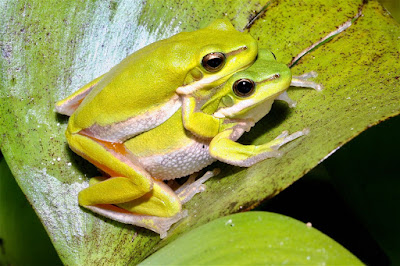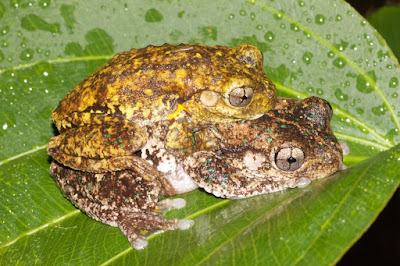And yet for some reason it has taken me since then to get around to writing about frogs and gardens.
Perhaps it was my dire lack of funky frog photos? The complex copyright/attribution issues around the workshop? Or simply the fact that frogs have never been top of the pile for me gardenwise (am I froggist??)? Who knows, but here's a short post on gardening for frogs, drawing on a wide range of sources including that workshop and also my personal experience.
Let's start with some frog images, courtesy of Garry Daly, before we get into the details.
 |
| Dwarf Tree Frogs. Who doesn't want some of these in their garden? Image by Garry Daly. |
 |
| Possibly even cuter than the Dwarf Tree Frogs, this is a Leaf Green Tree Frog. Image by Garry Daly. |
So: on to the details. Gardening for frogs.
Rule number one in gardening for frogs is: they need water.
Rule number two in gardening for frogs is: different frogs need different sorts and amounts of water. Anything from small areas of moisture to ponds and pools of different depths. Different ways to get into and out of the water. Different places to hide when they're in or out of the water. (Oh dear, this is all reminding me of why I didn't do a frog post before!)
That's about it, before getting into more detailed advice about what the different local frog species need. I'm not going to go there, though I'll keep updating this post as time goes by with more specific resources.
And to finish, here are some shots of the frog ponds at the University of Wollongong, where the extraordinary Anthony Wardle has done so much to provide habitat for local frog species. More than any of the words above, these images should give you some good ideas on how to garden for frogs.
If you're in any doubt on how to proceed, head down to UOW and see for yourself how many different frogs are hanging around on campus. The uni even has a fantastic list of fauna seen on site. Check it out at: https://www.uow.edu.au/about/services/environment/campus-environment/animals-of-wollongong-campus/.
In such incredibly hot and dry times, it's more important than ever to create and maintain habitat for the frogs, toads and other native fauna who share these special places with us.











No comments
Post a Comment